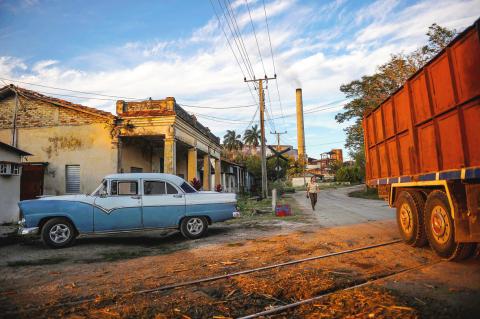A sweet smell of treacle used to fill the air in the village of Pedro Betancourt — but like the workers from the derelict Cuba Libre sugar refinery, it has dispersed.
It was the smell of success against the odds for Cuba, reviled by the US and its allies in the Cold War, but still a world champion sugar producer — until the Soviet Union fell and stopped buying it from late Cuban president Fidel Castro’s communist regime.
Now a demolition crane is attacking what is left of the Cuba Libre refinery’s rusty steel skeleton. Fidel is dead, the Cold War is over — and Cuba wants its sugar industry back.

Photo: AFP
“The refinery was the life of the people who lived here,” says Arnaldo Herrera, 86.
He lost his job at the plant when it closed in 2004.
“When that changes, life changes,” he says.

Photo: AFP
Britain and other colonial powers grew fat on Cuban sugarcane — harvested by black slaves — from the 18th century until independence at the turn of the 20th century.
The island then sold a lot of sugar to the US until Washington imposed a trade embargo after communist revolutionary Castro took over in 1959.
Castro later announced a “revolutionary offensive” to relaunch the industry. The Soviet Union bought the sugar at preferential prices.
For 1970 Castro famously set a production target of a “great harvest” of 10 million tonnes. He fell short by 1.5 million tonnes.
However, after the Soviet Union collapsed in 1989, with the US embargo still in place and prices falling, the island could no longer compete.
Two-thirds of its refineries — about 100 plants — have shut down since 2002.
From 8 million tonnes per year in the 1990s, production plunged to just more than 1 million tonnes in 2010.
“That was when we touched bottom,” says Rafael Suarez, head of international relations for the state sugar monopoly Azcuba. “Since then an effort has been made. The refineries have been improved and a lot of emphasis has been put on recovering sugarcane production.”
Suarez says Azcuba is also looking to expand production of sugar derivatives: rum, cattle feed and “renewable” fuel.
About 100,000 Cubans used to work in refineries like the one in Pedro Betancourt in the east.
The refineries used to pay well, for Cuba — at least double the US$28 average monthly salary.
Julio Dominguez, 84, worked in Cuba Libre until it shut.
“This town has been stripped bare. Tobacco production is all it has left,” he says.
The refinery stopped milling in 2004 and demolition began in 2007. Like everything in Cuba, it takes time.
“Some still weep when they pass the site,” says Eliecer Rodriguez, who heads the demolition. “I am knocking it down, but that was someone else’s decision.”
Workers were kept on their salaries for some time after the closure. Some have since moved on to work as tobacco producers, taxi drivers or handymen. Others have emigrated to the US.
“Closing a sugar refinery is always traumatic in human and social terms,” Suarez says. “What the revolution did was take a lot of care to see that no one was abandoned.”
Soon only the concrete smokestacks of Cuba Libre will stand among the green fields of sugarcane.
However, 70km away, a chimney is still smoking. The air smells of caramel. It is business as usual at the Jesus Rabi refinery.
The plant’s boiler operator Juan Hernandez, 63, was fired from two sugar plants that shut down before he landed there.
“Those were bitter times. When a sugar refinery shuts, it really shuts. There isn’t the economy for it,” he says.
Yet by mechanizing the sugar harvest almost completely, Cuba has managed to boost production to about 2 million tonnes per year from its 2010 low point.
More than half of that it exports, mostly to China and Russia.
Suarez says the island can hump up production to 4 million tonnes per year.
That will still leave it as a minnow in world terms.
“The days when such a small country as Cuba was the biggest exporter of sugar will never return,” he said. “We don’t pretend they will.”

WEAKER ACTIVITY: The sharpest deterioration was seen in the electronics and optical components sector, with the production index falling 13.2 points to 44.5 Taiwan’s manufacturing sector last month contracted for a second consecutive month, with the purchasing managers’ index (PMI) slipping to 48, reflecting ongoing caution over trade uncertainties, the Chung-Hua Institution for Economic Research (CIER, 中華經濟研究院) said yesterday. The decline reflects growing caution among companies amid uncertainty surrounding US tariffs, semiconductor duties and automotive import levies, and it is also likely linked to fading front-loading activity, CIER president Lien Hsien-ming (連賢明) said. “Some clients have started shifting orders to Southeast Asian countries where tariff regimes are already clear,” Lien told a news conference. Firms across the supply chain are also lowering stock levels to mitigate

Six Taiwanese companies, including contract chipmaker Taiwan Semiconductor Manufacturing Co (TSMC, 台積電), made the 2025 Fortune Global 500 list of the world’s largest firms by revenue. In a report published by New York-based Fortune magazine on Tuesday, Hon Hai Precision Industry Co (鴻海精密), also known as Foxconn Technology Group (富士康科技集團), ranked highest among Taiwanese firms, placing 28th with revenue of US$213.69 billion. Up 60 spots from last year, TSMC rose to No. 126 with US$90.16 billion in revenue, followed by Quanta Computer Inc (廣達) at 348th, Pegatron Corp (和碩) at 461st, CPC Corp, Taiwan (台灣中油) at 494th and Wistron Corp (緯創) at

NEW PRODUCTS: MediaTek plans to roll out new products this quarter, including a flagship mobile phone chip and a GB10 chip that it is codeveloping with Nvidia Corp MediaTek Inc (聯發科) yesterday projected that revenue this quarter would dip by 7 to 13 percent to between NT$130.1 billion and NT$140 billion (US$4.38 billion and US$4.71 billion), compared with NT$150.37 billion last quarter, which it attributed to subdued front-loading demand and unfavorable foreign exchange rates. The Hsinchu-based chip designer said that the forecast factored in the negative effects of an estimated 6 percent appreciation of the New Taiwan dollar against the greenback. “As some demand has been pulled into the first half of the year and resulted in a different quarterly pattern, we expect the third quarter revenue to decline sequentially,”

ASE Technology Holding Co (ASE, 日月光投控), the world’s biggest chip assembly and testing service provider, yesterday said it would boost equipment capital expenditure by up to 16 percent for this year to cope with strong customer demand for artificial intelligence (AI) applications. Aside from AI, a growing demand for semiconductors used in the automotive and industrial sectors is to drive ASE’s capacity next year, the Kaohsiung-based company said. “We do see the disparity between AI and other general sectors, and that pretty much aligns the scenario in the first half of this year,” ASE chief operating officer Tien Wu (吳田玉) told an